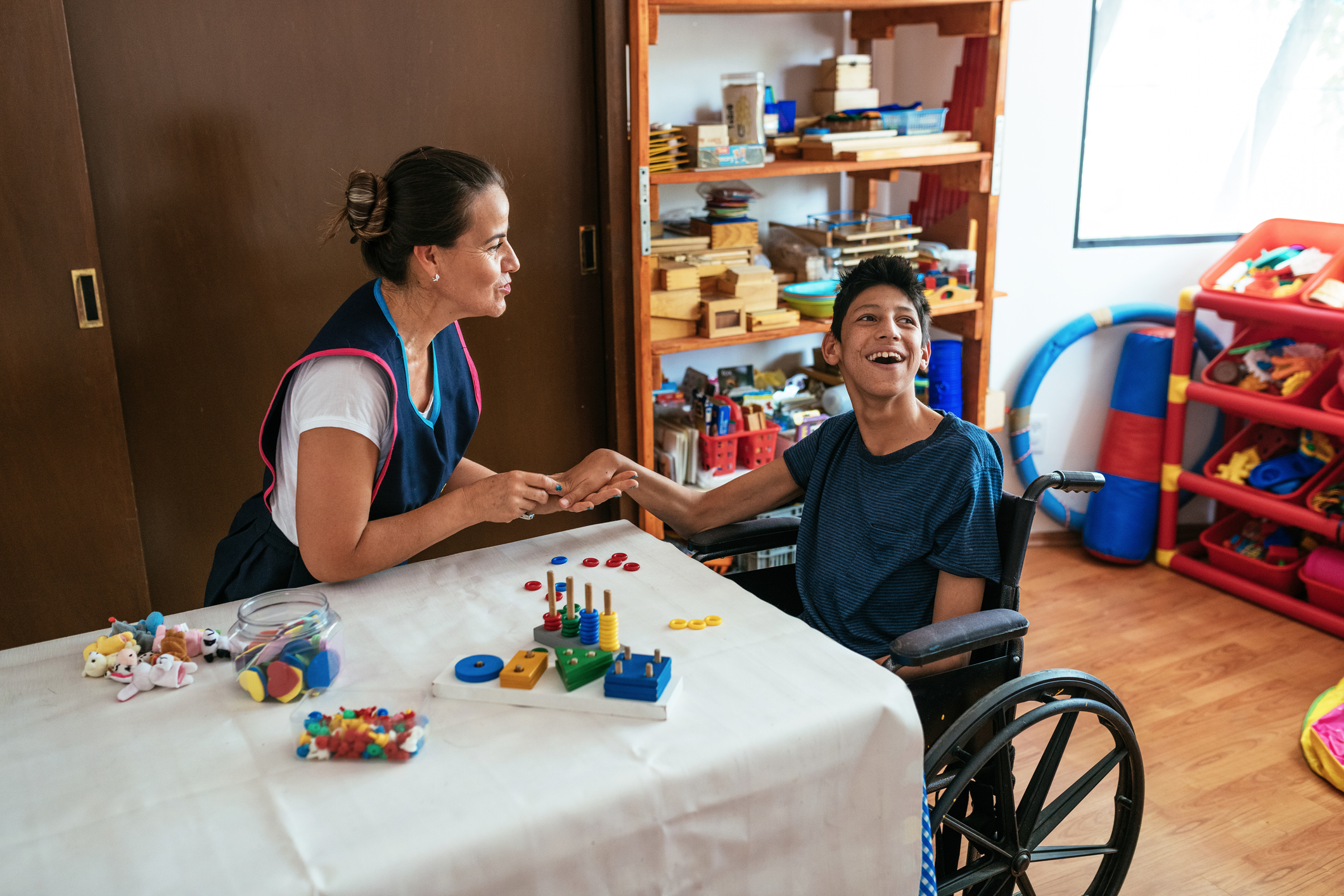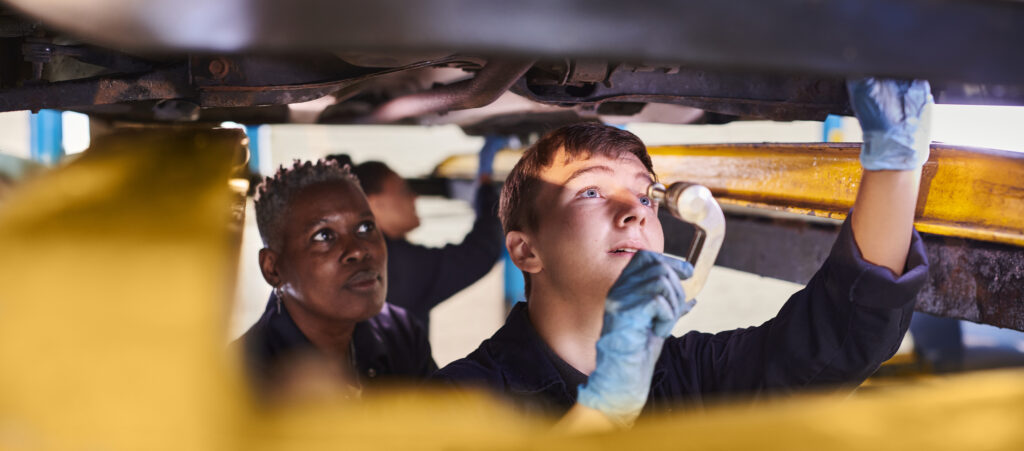
A £5 million loan to save a children’s charity
“It would have been hugely difficult if we’d closed down; there’s hardly anywhere else for these children to go. But we didn’t have enough cash to keep going, and we couldn’t get a loan from a high street bank.”
As the only charity of its kind in the UK, The Children’s Trust plays a crucial role in supporting children with acquired brain injuries and neurodisability. A series of difficulties meant the charity was spending around £350,000 a month more than it was bringing in.
It was clear that something had to change. The Children’s Trust drew up a recovery plan and turned to Charity Bank for a loan. Charity Bank were able to offer the charity £4 million and arrange a further £1 million loan from Big Society Capital.
The Children’s Trust’s Director of Finance, Elizabeth Sell, and Director of Therapies and Education, Melanie Burrough, share how the loans are helping the charity on its road to recovery.
Why did you need a recovery plan?
Elizabeth: A number of factors meant that we weren’t bringing in enough money to cover our costs. Whilst our bed occupancy targets were largely met during the height of the Covid-19 pandemic, towards the end of 2021-22, beds began to close with increasing rates of staff sickness absence due to stress and fatigue and the nationally reported exodus of nurses from the healthcare profession. The Covid grants we had benefited from during the pandemic had ceased and recruiting and retaining sufficient nurses was an enormous challenge. The organisation also hadn’t managed to negotiate fee increases to cover inflation and the increasing levels of complexity and intensity of care, therapy and education required for many of our children and young people. Our outgoings had risen considerably. For example, we had to spend a lot of money on recruitment, staff incentivisation (such as accommodation) and retention over the last few years, as there’s a real shortage of staff in this sector.
Our facility is a Queen Anne, Grade I-listed building on 23 acres of beautiful Surrey countryside, so we have high maintenance overheads and recently needed to make a significant investment in capital expenditure. We’re asset rich but cash poor. In 2019 we also committed to a significant, multi-year, strategic IT transformation programme, with the aim of digitising the workplace and moving our core systems into the cloud.
When I joined the organisation last year, it had become absolutely clear that the level of operating and capital expenditure the charity was incurring was unsustainable. We didn’t have enough cash to keep going. We couldn’t survive by just trimming costs and making a few cuts; we needed a complete organisational restructure. So, we needed to take a loan out against the value of the property over a significant period of time, to give us the ability to restructure, work through our recovery plan, and focus on rebuilding our financial stability.
Melanie: I have been Director of Therapies for the last 18 months and most recently taken on Director of Education oversight. It has been a very challenging time for the organisation undergoing a period of restructure and recovery, however, we are starting to move forwards, and we are in a much better place now. Thanks to Charity Bank, we are now a more sustainable organisation and can still be here for the children, young people and their families that we support.
How did the two loans come about?
Elizabeth: Luckily, one of the trustees was aware of Charity Bank. We couldn’t have got a loan from a high street bank in our financial position.
We needed a specialist lender who absolutely understood the sector and the level of change that we needed to make, and who was prepared to come with us on our recovery journey. There are very few organisations like that.
Charity Bank is unique. It’s owned by charities and interested in the impact, not just the finances.
How did you find the loans process?
Elizabeth: It was quite straightforward but really thorough. I was relatively new to the organisation, so I couldn’t always answer the questions, but that made me dig out the information, which was actually quite useful. It’s reassuring that Charity Bank now has such a high level of knowledge about our situation and our recovery plan.
Because of the nature of the problems we were experiencing, the precariousness of our situation and the size of the loan, Charity Bank asked for an independent business review, which was like going through a double audit with an external firm of accountants. That gave us a second opinion on whether the recovery plan would work, and whether anything else was likely to come out of the closet. The building was also revalued, and it turned out to be worth around £4 million more than we thought.
Do you have flexibility to pay back the loan early if you can?
Elizabeth: Yes, we do, which is obviously a marvellously attractive thing. We can’t refinance and pay it back, but if we got a large legacy, Charity Bank would have no problem with us paying off a million pounds of what we’ve drawn down. They’ve also been very flexible in other ways. For the first three years, we’re only paying the interest on the loan, and then from year four, we’re paying interest and capital. And it’s not like a mortgage, where we’d have had to draw down all the money and pay interest on it from day one; we’ve only drawn down £3.5 million so far. We don’t have to pay interest on the rest of the money; there’s just a tiny fee for having the extra £1.5 million there if we need it.
Were your contacts at Charity Bank helpful through the loans process?
Elizabeth: Carolyn Sims has been incredibly supportive and clearly did a lot of research into The Children’s Trust before we met. She passed the case onto Peter Hughes and Jerry Moore , who were great. It was hugely helpful having named people to speak with. We had regular face-to-faces throughout the loans process, and we still speak often as Charity Bank is monitoring the progress made on the recovery plan.
It’s a really good relationship. There’s openness and trust. It’s been as good an experience as it could be, bearing in mind how scary it is to need a £5 million loan. It’s felt like a very positive move forwards.
How long did the loan process take?
We had an initial conversation with Carolyn over the summer. Charity Bank wanted to know what our recovery plan was before we could formally apply for the loan. So, we formulated our plan in October; it was signed off by trustees in the first week of November, and then we shared that with Charity Bank. We couldn’t draw any money down until certain conditions had been met, which happened in March.
How did the loan from Big Society Capital come about?
Elizabeth: Charity Bank was the agent for that second loan and has managed everything. So, from our point of view, it feels as though it’s all coming from one lender, which has made the process much simpler.
What would have happened if you hadn’t been able to get a loan?
Elizabeth: Because of the nature of what we do, it would have been hugely difficult for the NHS and the local authorities if we’d closed down, particularly given the children we have in residential care. There’s hardly anywhere else for these children to go. In the short term, they’d have gone back into hospital, but hospitals aren’t geared up to offer what we do.
We also didn’t have sufficient cash resources to be able to cover the cost of closing so we really were in a very precarious position. We wouldn’t have been able to sell the building quickly enough to get the cash and pay people off.
What kinds of changes have you made?
Elizabeth: We had to lose almost 20% of our staff, which was painful. We’re having to be more commercially minded, and very firm with the local authorities about our new rates. We’ve been absolutely clear that we cannot afford to subsidise children who should be fully funded by local authorities. We have a plan. Charity Bank have reviewed it thoroughly. They believe we can do it; we believe we can do it, but we’ve got to actually deliver it. So, this first year is absolutely critical.
However, we’re already performing slightly ahead of our recovery plan and there are so many opportunities for us going forwards. We have capacity for 51 beds across the organisation, supporting in-patient neurorehabilitation and residential school placements.
Melanie: We have also recently launched a new community rehabilitation team who provide either outpatient or outreach support for children and young people in their local community. This is a new way of generating income for us, and there’s real potential to scale up in that area.
This is specifically for children residing in the South East and we have also launched nationally available digital resources to support families who have experienced traumatic brain injuries and a telehealth team that offer advice and coaching to families around the country.
Elizabeth: And, of course, not only is this an opportunity to grow income and make us more financially secure, it also means we’re expanding our charitable work.
Part of the loan was to pay off other debts. Why did you want to consolidate those debts?
Elizabeth: We owed our suppliers around £250,000. We also hadn’t been able to pay our tax bill, which meant we were being fined significant amounts of money by HMRC.
We had two people managing the creditors because so many people were calling in asking to be paid. Other staff members were also being frequently contacted, and we were having to work to find new suppliers because the old ones wouldn’t supply us anymore. So, the debts were costing us an awful lot of time and money. Paying them off provided an immediate saving.
We’re now in a very reasonable position in terms of working capital and cash. We’re rebuilding relationships and paying our creditors on time.
How did your trustees feel about taking out such a large loan?
Elizabeth: I think everyone realised it was the best option. Obviously, there was some nervousness, mainly due to the fact that we don’t have our long-term strategic plan pinned down yet. The recovery plan shows that we can afford to make the loan repayments over the next five years, but the loan is over 25 years. We’re in phase one; there are critical things that we need to decide as an organisation before we can look at phase two. We’re in the process of changing our chief executive and our chair of trustees. This uncertainty is one of the reasons why it would have been so difficult for us to get funding from anybody else.
What might phase two look like?
Elizabeth: It will be focused on making the organisation financially viable and sustainable for the future. Several other charities have moved away from heritage assets. Beautiful as these buildings are, they’re not ideal for modern medical care. We also want to expand, which may mean we’ll need a different home. So the new leadership team will need to decide whether we stay on the site, sell off the mansion and keep the rest of the land, or completely move to a modern, purpose-built building.
What would you say to other charities in a similar situation who are thinking of taking out a loan?
Elizabeth: You need a really robust recovery plan, and for everybody in your organisation to be 100% behind it. Recovery is a very challenging process. It’s much better if you feel like you’re working in partnership with your lender rather than just being lent money. Charity Bank has shown much more interest and care than I would expect to get from ‘Mr High Street Bank’!
If you need a loan for your charity, please call Charity Bank on 01732 441919.
About Charity Bank
Charity Bank is the loans and savings bank owned by and committed to supporting the social sector. Since 2002, we have used our savers’ money to make more than 1380 loans totalling over £580m to housing, education, social care, community and other social purpose organisations.
Nothing in this article constitutes an invitation to engage in investment activity nor is it advice or a recommendation and professional advice should be taken before any course of action is pursued.


